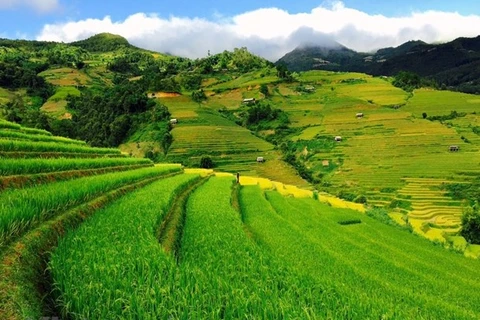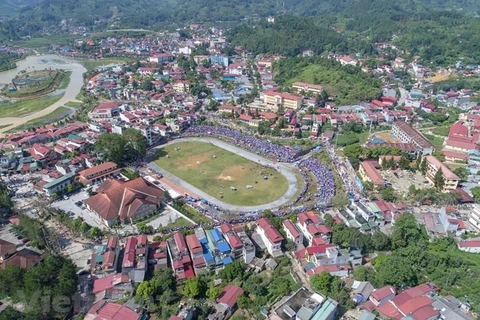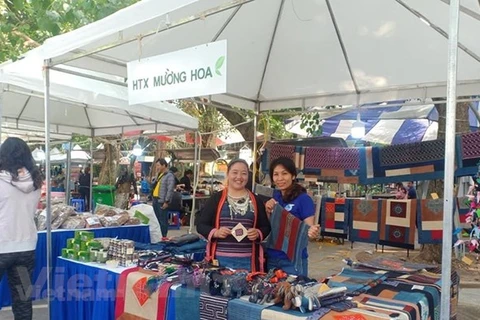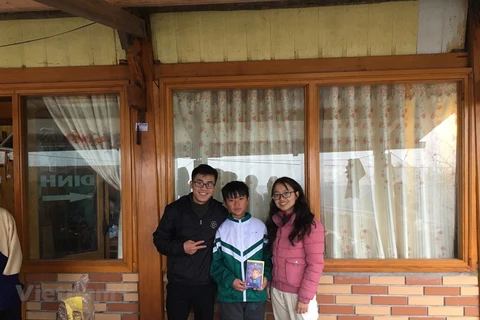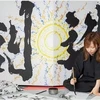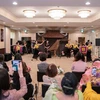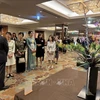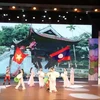Hanoi (VNA) - Khen (panpine) has played an important role in the cultural and spiritual life of the Mong people in the northernmost province of Ha Giang.
Meticulously made
The Mong people make up the majority of the population on Dong Van Karst Plateau in Ha Giang province. Khen, a traditional musical instrument indispensable in their daily life, has created a unique feature of the local culture.
Its shape, structure and sound function have made the panpine unique. Notably, its sounds come through both exhalation and inhalation.
Each panpine has six bamboo tubes of different lengths and widths, arranged closely together with one end connected to a gourd. The brass bar (the reed) is the only part made of metal.
Panpine gourds are usually made of pine wood, kim giao (Nageia fleuryi) and po mu (Chamaecyparis hodginsii).
There are no common standards for panpine making which, however, requires ingenuity, patience and experience.
Khen is often played at Mong festivals and New Year celebrations by young Mong men who dance at the same time to show off their strength, sensibility and skills. They learn to play the musical instrument when they are small. Boys often carry a Khen to terraced fields or market fairs.
At festivals, the melodies of Khen echo over mountains and forests, expressing wishes of the Mong people. Mong men who play the Khen and dance exceptionally well are admired by villagers. At funeral ceremonies, the panpine, on behalf of the living, talks to the soul of the dead. Meanwhile, at wedding parties, it conveys parents’ wishes to their children.
Preserving the craft
Although local residents have seen their living standards improved significantly, they still preserved the art of panpine making. Local artisans in hamlets have continued to make the traditional musical instrument.
Sung Trai is one of the communes in the Dong Van Karst Plateau where panpine making has been preserved.
 Mua Mi Tua, an artisan in Tia Sung hamlet, Sung Trai commune, Ha Giang province’s Dong Van district (Photo: VNA)
Mua Mi Tua, an artisan in Tia Sung hamlet, Sung Trai commune, Ha Giang province’s Dong Van district (Photo: VNA) Born in 1985, Mua Mi Tua started playing the panpine when he was 14, and is currently the youngest in Sung Trai commune who knows how to play the instrument.
The man said his passion for the panpine was nurtured when he was small, and he can make panpines himself.
"Once you know how to play the panpine and understand its melodies, you can make a good panpine," Tua said.
Over the past years, with support of local authorities, many panpaine making groups have been established, and training classes opened, aiming to preserve the traditional craft and promoting local tourism.
Pham Quoc Lap, head of Dong Van district’s Culture and Information Bureau, said in an effort to preserve and promote traditional cultural values of ethnic minorities in the district in general, and the Mong people in particular, Dong Van district has restored traditional festivals and craft villages associated with tourism development and poverty alleviation.
Legend has it that long ago, an old couple gave birth to six children. When they passed away, the children cried their eyes out and blew through small bamboo tubes to tell of their sorrows for the death of their parents and the loss of their love. Thereafter, the Mong people started to compose touching melodies to show their sentiments toward their ancestors.
Despite changes in society, the Mong have preserved the Khen as the soul of their culture. Many men continue to make the instrument and pass on the techniques to younger people.
The panpine gained the national intangible heritage status from the Ministry of Culture, Sports and Tourism in 2015./.


